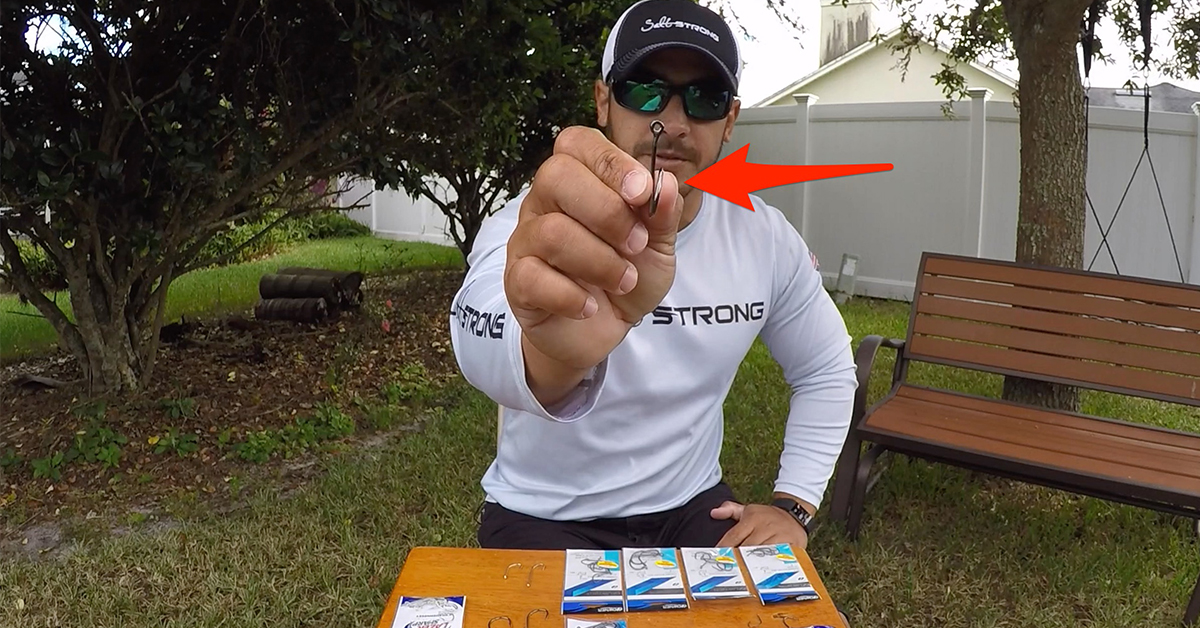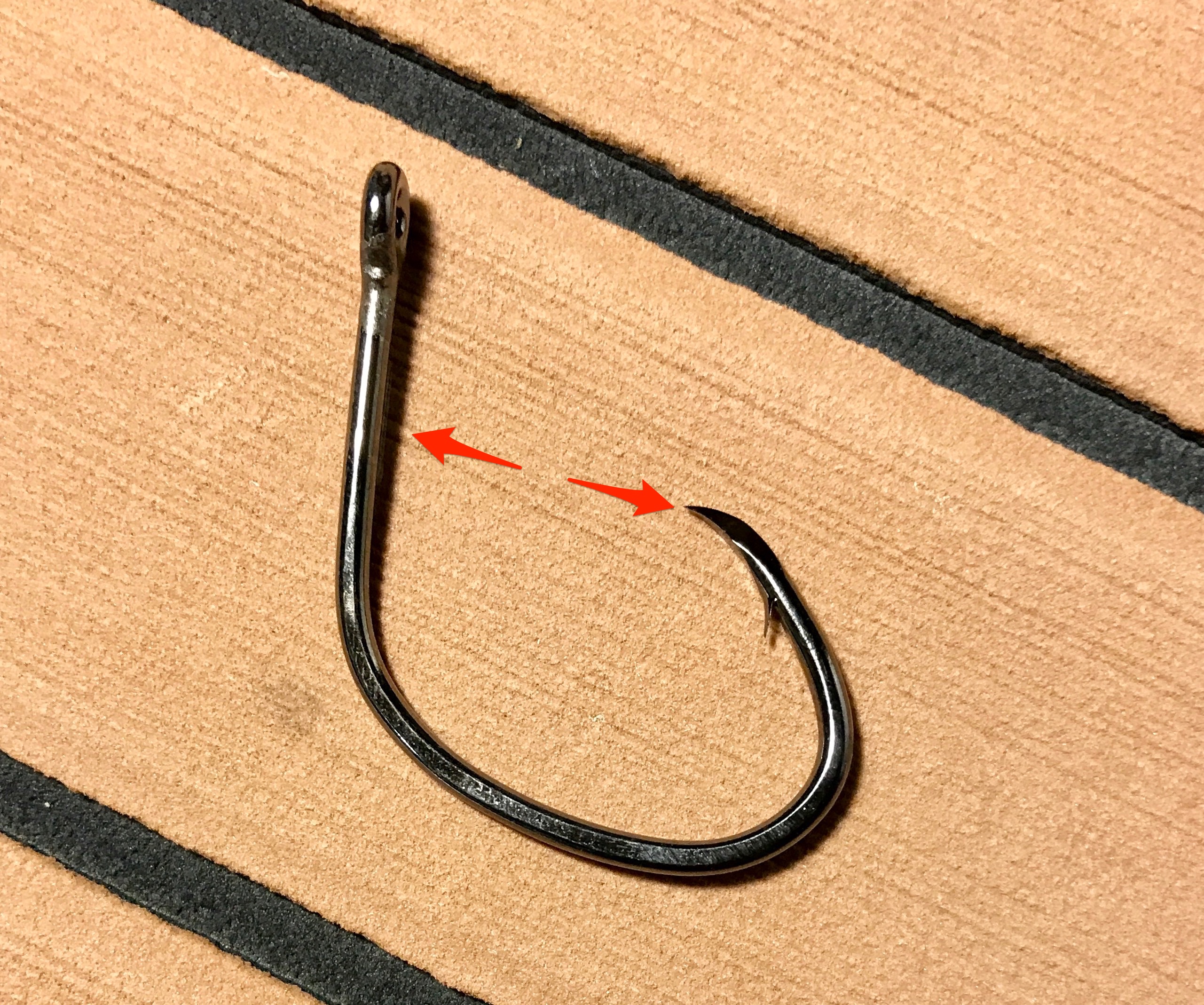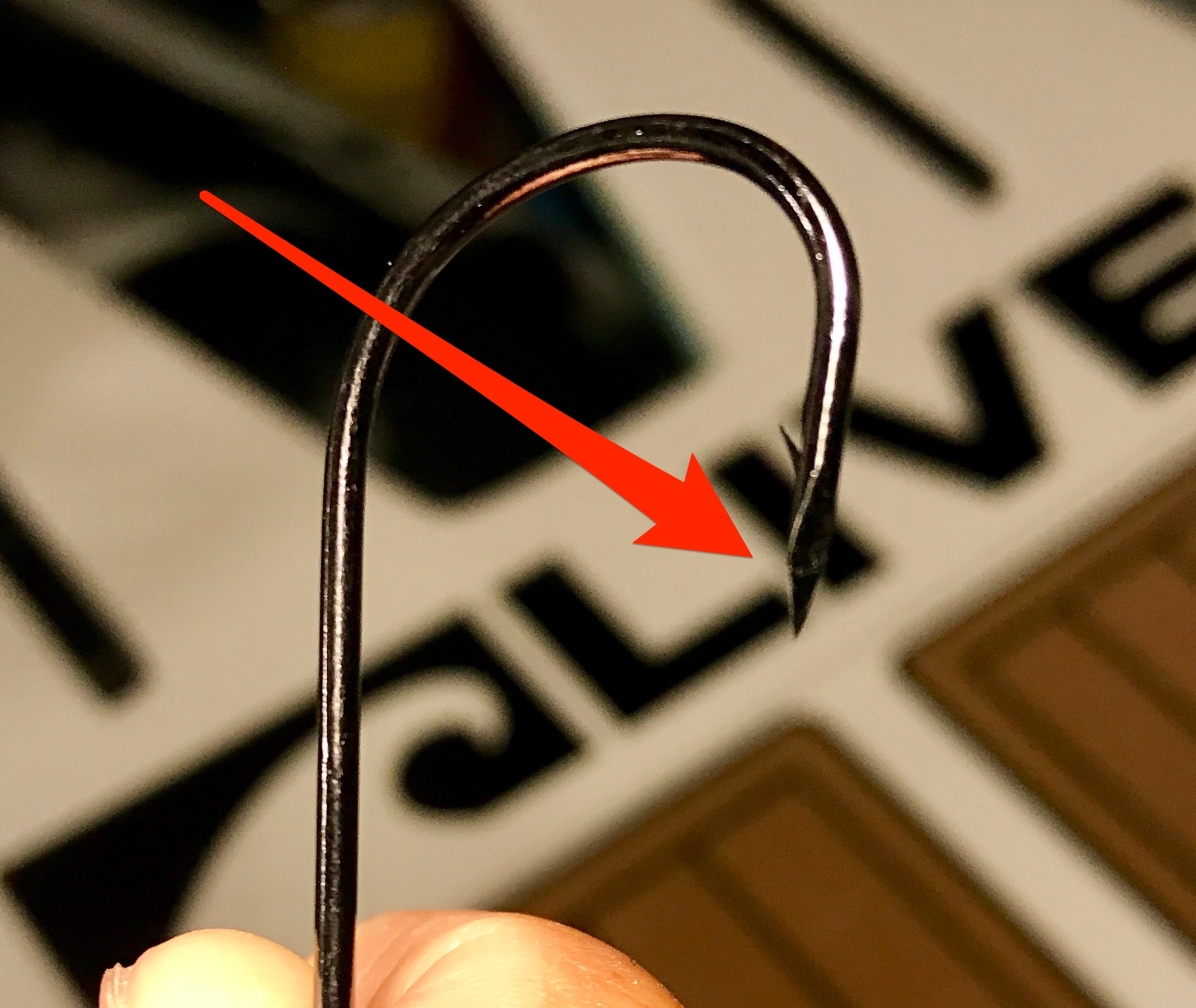How To Pick The Best Inshore Hook When Fishing Live Bait Or Cut Bait
- By: Tony Acevedo
- on
- Found In: Fishing Tips, Inshore Fishing

What is the most important link between you and a fish?
The hook, of course!
Unless you are an expert at snaring fish using your fishing line (or you are a noodler), the hook is possibly one of the most important pieces of the fishing rod and reel setup.
It is the very last link connecting you to the fish.

With how important this piece of tackle is, you would be surprised by how overlooked hooks are by anglers – from beginners to the advanced.
When we walk into our local tackle shops or sporting goods stores, there is always one aisle (and sometimes more) that is lined from end to end with various shapes, sizes, brands, colors, and styles of hooks you can think of.

I really want to narrow down what types of hooks you should be using for inshore fishing with live or cut bait, and help you better understand why some hooks are made the way they are.
The 2 Best Hooks For Inshore Fishing:
The “J” Hook

The J-hook has been around for as long as fishing has existed, and when you think of a fishing hook, this is typically the style that comes to mind.
Let’s take a look at some Pros and Cons of the J-Hook:
Pros
- Longer shank J-Hooks help keep toothy fish from breaking you off
- Great around structure – as you set the hook, this pulls fish away from structure
- Typically cost less than circle hooks
Cons
- High risk of gut hooking or foul hooking a fish
- Missed strikes due to poor hook setting (more common with beginner anglers)
- Can be tough to remove if hooked deep into the mouth of a fish – best to cut the line
The Circle Hook

This style of hook is a bit different than that of the J-Hook.
Instead of the point of the hook facing straight up, it is actually facing 90 degrees to the shank of the hook, creating a circular gap in the hook.
Circle hooks are most popular with catch and release fishermen, but are also used by those harvesting fish that may live around other protected species that have to be released and are unintentionally caught.
Now let’s see the Pros and Cons of the Circle Hook:
Pros
- Very minimal risk of gut hooking or foul hooking a fish
- No hook set required – great advantage for beginner anglers – just let the fish run.
- With hook sets settling in the lip of the fish, much easier to remove than a J-Hook
Cons
- “Offset” Circle Hooks can still gut hook fish
- A little more expensive than standard J-Hooks
- Not the best around structure since the fish has to run for the hook to set
Let’s Get to the Point (pun intended)
Ready to over the two main types of points on a fishing hook?
It is very important to know the different types of hook points out there, as they will determine which species of fish they are best suited for.
First, is a Needle Point hook.

The tip of this hook is round and will easily penetrate the mouth of a fish that is relatively soft.
These fish include Speckled Seatrout, and Snook.
Second, Is The Cutting Point Hook

The tips of these hooks may be triangular in shape, or have a blade-like edge on them which is suited for digging into the mouth of a fish that is very tough.
These fish include Redfish, Tarpon, Drum, and Sheepshead.
You do not want to use these hooks when targeting fish with soft mouths because it will create a larger hole and really tear into the mouth, causing you to lose more fish from the hook falling out.
In the following video, I have put together some tips that will help you better understand J-Hooks and Circle Hooks for inshore fishing with live or cut bait.
By the end, you should have a better understanding of which hook will work best for you depending on what species you are targeting, and the type of structure you are targeting them in.
Enjoy!
Choosing The Right Hook for Live or Cut Bait [VIDEO]
Conclusion
As you can see, both circle hooks and j-hooks have their own advantages and disadvantages.
I would definitely keep both types in my tackle box at all times.
Any questions about choosing the right hook for live bait or cut bait when inshore fishing?
Let me know in the comments!
Fish on!
Related Posts:
- The 3 Best Live Bait Fish For Inshore Fishing In Florida [Gulf Coast] See It Here
- How To Hook A Shrimp Like A Pro – See It Here
P.S. – If you think your angler friends or fishing networks would like to see this, please Tag them or Share this with them.
Fish On!
Related categories:
STOP WASTING TIME ON THE WATER!
Do what the “SMART ANGLERS” are doing and join the Insider Club.
Here’s what you’ll receive today when you join:
- Weekly fishing reports and TRENDS revealing exactly where you should fish every trip
- Weekly “spot dissection” videos that walk you through all the best spots in your area
- Exclusive fishing tips from the PROS you can’t find anywhere else
- Everything you need to start catching fish more consistently (regardless if you fish out of a boat, kayak, or land).









I’m sorry for asking so many questions. My Dad is the one who got me into fishing. He fished the Tampa Bay since he was just a little kid and growing up would take myself and two old sisters fishing. My two older sisters never really got into it. As for myself, it wasn’t until my adult years that I reeeally fell in love with fishing and bought my first boat a few years ago. I wish I would have got more time with him, when he was well, as I know he could have taught me sooo much. Sadly enough, he was diagnosed with Parkinson’s back in 2005 and past away July before last and by the time I purchased my first boat, he didn’t have the hand coordination, amongst other things to be able to teach me all of the tips and tricks that he wanted to so badly. That being said, before he past away, he gave me something (that to me, was priceless). Close to a dozen pages of Loran coordinates for fishing holes up in Hernando Co & as far north as Crystal River (Citrus Co) with a few in Tarpon (closer to where I’m located in Dunedin).
Since then, I’ve been trying to learn as much as I can about deep sea fishing so that when I do finally get’ to explore these fishing holes, I’ve got the right tackle in place.
In addition to subscribing to your channel (which you guys have been a wealth of knowledge), I also rented a private charter down in St. Pete. The captain is pretty darn good. He almost always catches his bag limits and we did the day I went out as well. When I asked them how they rigged the lines, he told me (when fishing for grouper) they use an 80 lb. braided line, to 50 to 60’ of 60-80 lb mono with a Texas rig and the appropriate egg sinker above 36” of fluoro tied to double J hooks and said they usually use Mustad Beak hooks.
I wish I would have asked more but really hoping you can help!
1) Does the finish of the hook matter? A while back, I remember someone telling me to always go with a darker hook, as the fish can see the hook a lot better when it’s a nickel (silver) finish? Is there any validity to this? Would you recommend any particular Mustad beak J hook when fishing for grouper or red snapper with sardines and live pin fish and if so what size or sizes?
2) When we were fishing for grouper, the egg weight was right above the double J hook (with one going through the nose and the other in the belly (if I remember correctly) but I remember the egg weight being higher up when we fished for red snapper. What would this type of setup be called and how would you hook the pin fish or sardine when fishing for red snapper?
3) What size power swivel do you recommend?
4) When we were fishing for grouper it was 80 lb braded line to 60’ mono…however I remember him telling me they were using a slightly lighter braided line/mono/flouro when we fished for red snapper? When using this method what weight would you recommend for the braided/mono to flouro line set up?
I know I’m asking for a lot but ANY advice would be greatly appreciated.
Look forward to hearing from you! 🙂
Sincerely,
Carrinne
Hey Carrine! I see your dad has passed on the fishing legacy, which is awesome! I’m sure you guys have many memories you can still hold on to!
As for the questions you had, be sure to check local regulations on hooks for fishing in the Gulf. I know a lot of guides use certain setups but if you are fishing for particular species (reef fish) you have to use circle hooks. That same rig can be used with circle hooks as well (j-hooks tend to get more of a hookup so thats why most people will still use them, but you run the risk of getting fined). Here is a video showing that double snell rig:
https://www.saltstrong.com/fishing-tip/deadly-snapper-grouper-rig-insider/
Lastly, as an Insider be sure to post this question on the community page where you will get many more responses from other members and instructors!
https://community.saltstrong.com
What would be the best size and type hook for snuck using 4 or 5″ pilcher So it does not hook back into itself
Tony
Very appreciative of your very clear and extremely helpful explanation on hooks. I;ve used gamegatsu, owner, mustad , vmc mostly.
Do you have a favorite brand and is there a particular store where I imagine you might buy them in bulk.
again, great information
Thank you for the great feedback! I prefer Owner hooks. We have a few options on our shop page here – and if you’re an Insider Member you get 20% discount so you can definitely stock up:
https://fishstrong.com/collections/saltwater-hooks
This was really great info. I once fished an offset eye hook tied with a uniknot and realized I couldn’t set the hook and switched out.. Now I know why. However, a question: Are some hooks a ‘combination’ of the two hook styles J and circle eg a Kahle hook?
Excellent information
That was really helpful.????????
Great video. Ive been using the offset eye and missed tons of hook ups now i know why. Now i could be wrong cause theres so many. But are there hooks with the eye offse the opposite of the 1 you showed. So is it better to just have the eye inline when using circle hooks and short shank j hooks for live bait.
Thanks for the advice. But whats the best hooks and size hooks for sheepsheads, trout, redfish, floundef etc? Is there a particular hook i can use for all?
Been searching relentlessly for information like this. Thank you so much. Super informative. Just what I needed.
No problem Rachel!
Tony, I’ve been using circle hooks for a couple of years fishing for seatrout and reds. I use a loop knot on straight circle hooks and Snell the octopus style circle hooks. Recently I have hit a streak of fouled circle hooks that hooked back into the bait and resulted in pulling the bait out of the fish’s mouth. Super frustrating. I’m not setting the hook like you would with a j hook. I’m reeling tight then lifting.
How can I prevent the fouled circle hook curse?
Hey Joe,
If the hook is pushing back into the bait, you may be hooking the bait too deep. Also, your hook may be too small. When using a circle hook, I like to make sure the hook point is exposed enough to grab my hand easily if i slide my hand over the bait towards the hook.
At times, it can be tough to keep the hook from fouling up, especially if you are fishing in current and the bait is tumbling around. Also, if you have other small fish picking at it, the bait will be bouncing around and your hook may foul up into your bait. Catfish are really good at re-hooking your bait and making it snagless haha.
Thanks Tony. Good info.